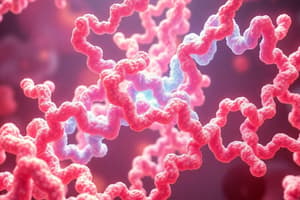Podcast
Questions and Answers
What is a key function of glutathione in the body?
What is a key function of glutathione in the body?
- Serves as a neurotransmitter
- Enhances iron absorption
- Protein synthesis
- Prevents oxidative damage to cells (correct)
Which amino acid is a precursor for creatine synthesis?
Which amino acid is a precursor for creatine synthesis?
- Aspartate
- Phenylalanine
- Tyrosine
- Arginine (correct)
What is the result of glycine cleavage enzyme activity?
What is the result of glycine cleavage enzyme activity?
- Conversion to pyruvate
- Synthesis of purines
- Production of creatine
- Formation of CO2 and NH3 (correct)
What happens to creatine during muscular exercise?
What happens to creatine during muscular exercise?
Which of the following describes glycine's nature?
Which of the following describes glycine's nature?
What is one of the detoxification roles of glycine?
What is one of the detoxification roles of glycine?
Which of the following is NOT an anabolic fate of glycine?
Which of the following is NOT an anabolic fate of glycine?
What form of glutathione contains a disulfide bond?
What form of glutathione contains a disulfide bond?
Flashcards
Glycine
Glycine
A non-essential amino acid that plays a vital role in various metabolic processes, including protein synthesis, detoxification, and energy production.
Glycine Cleavage Enzyme
Glycine Cleavage Enzyme
A metabolic pathway that involves the breakdown of glycine to produce carbon dioxide and ammonia. It's a crucial part of energy production.
Hippuric Acid
Hippuric Acid
A derivative of glycine, crucial for detoxification in the liver, particularly in eliminating benzoic acid, a food preservative.
Glutathione
Glutathione
Signup and view all the flashcards
G-SH
G-SH
Signup and view all the flashcards
G-S-S-G
G-S-S-G
Signup and view all the flashcards
Creatine Phosphate
Creatine Phosphate
Signup and view all the flashcards
Creatine Kinase (CK)
Creatine Kinase (CK)
Signup and view all the flashcards
Study Notes
Glycine Amino Acid Metabolism
- Glycine is a neutral, aliphatic, glucogenic, and non-essential amino acid.
Glycine Synthesis
- Glycine can be synthesized from:
- Threonine
- Serine
- Glyoxylic acid via transaminase
- Ammonia and CO2 via glycinesynthase
- Choline through the choline cycle
Glycine Catabolism
- Glycine is catabolized to produce CO2 and NH3 by glycine cleavage enzyme
- Glycine can be converted to glyoxylic acid through oxidative deamination or transamination
- Glyoxylic acid can then undergo oxidative decarboxylation to produce formic acid
- Glycine is also a gluconeogenic amino acid and can be converted to pyruvate. Pyruvate can then be converted to glucose
Glycine Detoxification
- Glycine participates in the detoxification of certain substances by conjugation
- Benzoic acid, a food preservative, is converted to hippuric acid during this process
Glycine Anabolic Fates
- Glycine is used in protein synthesis, including collagen synthesis
- It's involved in purine and porphyrin (precursor of hemoglobin) synthesis
- Glycine is also involved in bile salt synthesis
Glutathione Synthesis
- Glutathione exists in two forms:
- Reduced form (G-SH): contains a free sulfhydryl group
- Oxidized form (G-S-S-G): contains a disulfide bond
- Glutathione functions include:
- Amino acid absorption
- Coenzyme for several enzymes
- Detoxification reactions in the liver
- Hydrogen donor in redox reactions
- Inactivating insulin
- Protecting cell membranes from damage (e.g., preventing RBC hemolysis and protecting pancreatic beta cells)
Creatine Synthesis
- Creatine is present in both blood and muscle
- In blood, it's only free creatine. In muscle, it's present as both free creatine and creatine phosphate (also called phosphagen).
- Creatine is synthesized from arginine and glycine via two reactions:
- Transamidation in the kidneys
- Transmethylation in the liver.
- A small percentage of creatine and creatine phosphate is converted to creatinine, and excreted in the urine daily
- Serum creatinine levels are 0.6-1.2 mg/dL
Creatine Metabolism
- During rest, creatine is phosphorylated by creatine phosphokinase (CPK) using ATP, creating stored energy in the form of creatine phosphate (CP)
- During muscle exercise, creatine phosphate is dephosphorylated, regenerating ATP for energy production, catalyzed by creatine-ATP transphosphorylase.
Creatinine Clinical Significance
- Creatinine clearance rate from blood to urine is a measure of kidney function (Creatinine clearance test)
- High blood creatinine and urea levels indicate potential renal impairment like renal failure.
Studying That Suits You
Use AI to generate personalized quizzes and flashcards to suit your learning preferences.
Related Documents
Description
This quiz covers key concepts related to amino acids, particularly glycine and glutathione. Test your knowledge on their functions, synthesis, and roles in detoxification and muscular exercise. Perfect for students studying biochemistry or health sciences.



